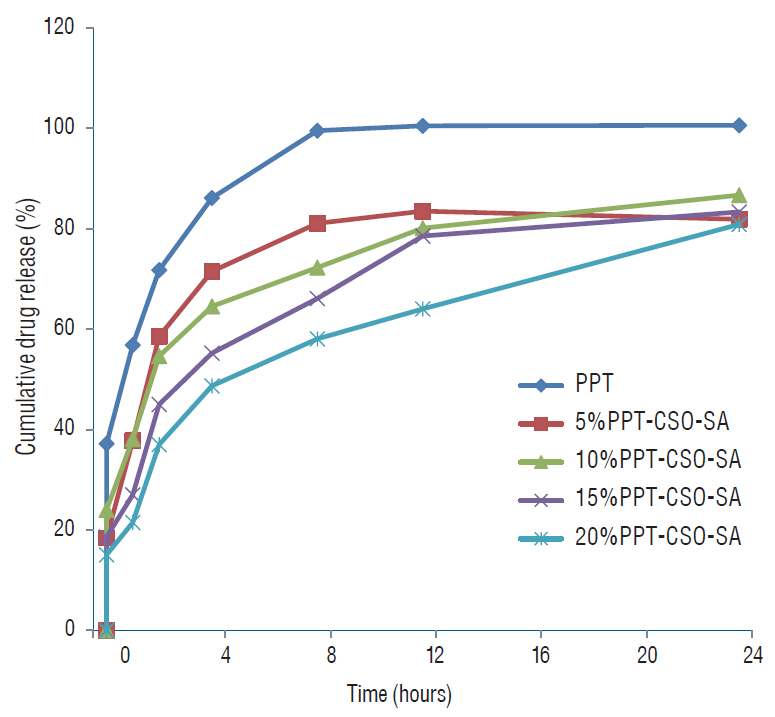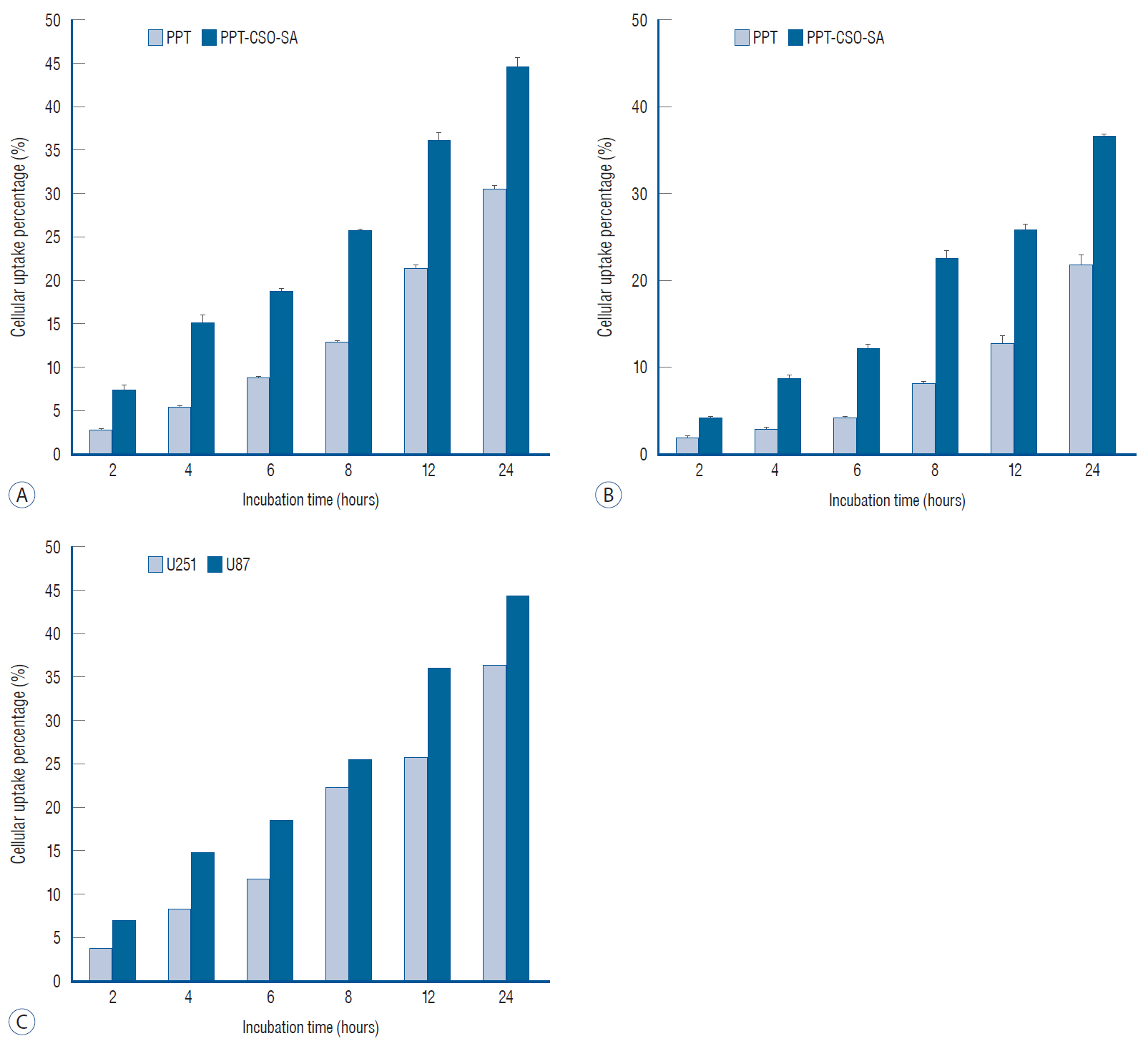J Korean Neurosurg Soc.
2020 Nov;63(6):698-706. 10.3340/jkns.2019.0206.
Effect of Podophyllotoxin Conjugated Stearic Acid Grafted Chitosan Oligosaccharide Micelle on Human Glioma Cells
- Affiliations
-
- 1Department of Neurosurgery, The Second Affiliated Hospital of Jiaxing University, Jiaxing, China
- 2Department of Pharmacy, Medical College, Jiaxing University, Jiaxing, China
- KMID: 2508599
- DOI: http://doi.org/10.3340/jkns.2019.0206
Abstract
Objective
: To study the physiochemical characteristics of podophyllotoxin (PPT) conjugated stearic acid grafted chitosan oligosaccharide micelle (PPT-CSO-SA), and evaluate the ability of the potential antineoplastic effects against glioma cells.
Methods
: PPT-CSO-SA was prepared by a dialysis method. The quality of PPT-CSO-SA including micellar size, zeta potential, drug encapsulation efficiency and drug release profiles was evaluated. Glioma cells were cultured and treated with PPT and PPT-CSO-SA. The ability of glioma cells to uptake PPT-CSO-SA was observed. The proliferation of glioma cells was determined by 3-[4, 5-dimethyl-2-thiazolyl]-2, 5-diphenyl-2H-tetrazolium bromide (MTT) assay. The apoptosis and morphology of U251 cells were observed by 4’,6-Diamidino-2-phenylindole dihydrochloride (DAPI) dye staining. Cell cycle analysis was performed by flow cytometry. The migration ability of U251 cells was determined by wound healing test.
Results
: PPT-CSO-SA had nano-level particle size and sustained release property. The encapsulation efficiency of drug reached a high level. The cellular uptake percentage of PPT in glioma cells was lower than that of PPT-CSO-SA (p<0.05). The inhibitory effect of PPT-CSO-SA on glioma cells proliferation was significantly stronger than that of PPT (p<0.05). The morphologic change of apoptosis cell such as shrinkage, karyorrhexis and karyopyknosis were observed. The percentage of U251 cells in G2/M phase increased significantly in the PPT-CSO-SA group compared with PPT group (p<0.05). Compared with the PPT group, the cell migration ability of the PPT-CSO-SA group was significantly inhibited after 12 and 24 hours (p<0.05).
Conclusion
: PPT-CSO-SA can effectively enhance the glioma cellular uptake of drugs, inhibit glioma cells proliferation and migration, induce G2/M phase arrest of them, and promote their apoptosis. It may be a promising anti-glioma nano-drug.
Keyword
Figure
Reference
-
References
1. Castro A, del Corral JM, Gordaliza M, Grande C, Gómez-Zurita A, García-Grávalos D, et al. Synthesis and cytotoxicity of podophyllotoxin analogues modified in the A ring. Eur J Med Chem. 38:65–74. 2003.2. De Campos AM, Sánchez A, Alonso MJ. Chitosan nanoparticles: a new vehicle for the improvement of the delivery of drugs to the ocular surface. Application to cyclosporin A. Int J Pharm. 224:159–168. 2001.
Article3. Desbène S, Giorgi-Renault S. Drugs that inhibit tubulin polymerization: the particular case of podophyllotoxin and analogues. Curr Med Chem Anticancer Agents. 2:71–90. 2002.
Article4. Ellingson BM, Cloughesy TF, Zaw T, Lai A, Nghiemphu PL, Harris R, et al. Functional diffusion maps (fDMs) evaluated before and after radiochemotherapy predict progression-free and overall survival in newly diagnosed glioblastoma. Neuro Oncol. 14:333–343. 2012.
Article5. Felix CA. Secondary leukemias induced by topoisomerase-targeted drugs. Biochim Biophys Acta. 1400:233–255. 1998.
Article6. Fisher RI, Gaynor ER, Dahlberg S, Oken MM, Grogan TM, Mize EM, et al. A phase III comparison of CHOP vs. m-BACOD vs. ProMACE-CytaBOM vs. MACOP-B in patients with intermediate- or high-grade non-Hodgkin’s lymphoma: results of SWOG-8516 (Intergroup 0067), the National High-Priority Lymphoma Study. Ann Oncol 5 Suppl. 2:91–95. 1994.
Article7. Gaucher G, Dufresne MH, Sant VP, Kang N, Maysinger D, Leroux JC. Block copolymer micelles: preparation, characterization and application in drug delivery. J Control Release. 109:169–188. 2005.
Article8. Gordaliza M, García PA, del Corral JM, Castro MA, Gómez-Zurita MA. Podophyllotoxin: distribution, sources, applications and new cytotoxic derivatives. Toxicon. 44:441–459. 2004.
Article9. Hu FQ, Liu LN, Du YZ, Yuan H. Synthesis and antitumor activity of doxorubicin conjugated stearic acid-g-chitosan oligosaccharide polymeric micelles. Biomaterials. 30:6955–6963. 2009.
Article10. Hu FQ, Ren GF, Yuan H, Du YZ, Zeng S. Shell cross-linked stearic acid grafted chitosan oligosaccharide self-aggregated micelles for controlled release of paclitaxel. Colloids Surf B Biointerfaces. 50:97–103. 2006.
Article11. Hu FQ, Zhao MD, Yuan H, You J, Du YZ, Zeng S. A novel chitosan oligosaccharide-stearic acid micelles for gene delivery: properties and in vitro transfection studies. Int J Pharm. 315:158–166. 2006.
Article12. Huang X, Huang X, Jiang XH, Hu FQ, Du YZ, Zhu QF, et al. In vitro antitumour activity of stearic acid-g-chitosan oligosaccharide polymeric micelles loading podophyllotoxin. J Microencapsul. 29:1–8. 2012.
Article13. Jansen M, Yip S, Louis DN. Molecular pathology in adult gliomas: diagnostic, prognostic, and predictive markers. Lancet Neurol. 9:717–726. 2010.
Article14. Lara PN, Natale R, Crowley J, Lenz HJ, Redman MW, Carleton JE, et al. Phase III trial of irinotecan/cisplatin compared with etoposide/cisplatin in extensive-stage small-cell lung cancer: clinical and pharmacogenomic results from SWOG S0124. J Clin Oncol. 27:2530–2535. 2009.
Article15. Li SD, Huang L. Pharmacokinetics and biodistribution of nanoparticles. Mol Pharm. 5:496–504. 2008.
Article16. López-Pérez JL, del Olmo E, de Pascual-Teresa B, Abad A, San Feliciano A. Synthesis and cytotoxicity of hydrophobic esters of podophyllotoxins. Bioorg Med Chem Lett. 14:1283–1286. 2004.
Article17. Louis DN, Ohgaki H, Wiestler OD, Cavenee WK, Burger PC, Jouvet A, et al. The 2007 WHO classification of tumours of the central nervous system. Acta Neuropathol. 114:97–109. 2007.
Article18. Moreira JN, Gaspar R, Allen TM. Targeting Stealth liposomes in a murine model of human small cell lung cancer. Biochim Biophys Acta. 1515:167–176. 2001.
Article19. Pedersen-Bjergaard J. Radiotherapy- and chemotherapy-induced myelodysplasia and acute myeloid leukemia. A review. Leuk Res. 16:61–65. 1992.
Article20. Qin L, Xue M, Wang W, Zhu R, Wang S, Sun J, et al. The in vitro and in vivo anti-tumor effect of layered double hydroxides nanoparticles as delivery for podophyllotoxin. Int J Pharm. 388:223–230. 2010.
Article21. Sackett DL. Podophyllotoxin, steganacin and combretastatin: natural products that bind at the colchicine site of tubulin. Pharmacol Ther. 59:163–228. 1993.
Article22. Schönbrunn E, Phlippen W, Trinczek B, Sack S, Eschenburg S, Mandelkow EM, et al. Crystallization of a macromolecular ring assembly of tubulin liganded with the anti-mitotic drug podophyllotoxin. J Struct Biol. 128:211–215. 1999.
Article23. Stummer W, Meinel T, Ewelt C, Martus P, Jakobs O, Felsberg J, et al. Prospective cohort study of radiotherapy with concomitant and adjuvant temozolomide chemotherapy for glioblastoma patients with no or minimal residual enhancing tumor load after surgery. J Neurooncol. 108:89–97. 2012.
Article24. Venishetty VK, Komuravelli R, Kuncha M, Sistla R, Diwan PV. Increased brain uptake of docetaxel and ketoconazole loaded folate-grafted solid lipid nanoparticles. Nanomedicine. 9:111–121. 2013.
Article25. You J, Hu FQ, Du YZ, Yuan H. Polymeric micelles with glycolipid-like structure and multiple hydrophobic domains for mediating molecular target delivery of paclitaxel. Biomacromolecules. 8:2450–2456. 2007.
Article26. Zhan C, Lu W. The blood-brain/tumor barriers: challenges and chances for malignant gliomas targeted drug delivery. Curr Pharm Biotechnol. 13:2380–2387. 2012.
Article27. Zhang L, Wu X, Xu T, Luo C, Qian J, Lu Y. Chemotherapy plus radiotherapy versus radiotherapy alone in patients with anaplastic glioma: a systematic review and meta-analysis. J Cancer Res Clin Oncol. 139:719–726. 2013.
Article28. Zhu RR, Qin LL, Wang M, Wu SM, Wang SL, Zhang R, et al. Preparation, characterization, and anti-tumor property of podophyllotoxin-loaded solid lipid nanoparticles. Nanotechnology. 20:055702. 2009.
Article
- Full Text Links
- Actions
-
Cited
- CITED
-
- Close
- Share
- Similar articles
-
- Antioxidative Effects of Water-Soluble Chitinous Compounds on Oxidation of Low Density Lipoprotein in Macrophages
- Effects of C18 Fatty Acids on Intracellular Ca2+ Mobilization and Histamine Release in RBL-2H3 Cells
- Attachment and Growth of Cultured Fibroblasts on Chitosan Sponge
- Inhibition of miR-146a-5p and miR-8114 in Insulin-Secreting Cells Contributes to the Protection of Melatonin against Stearic Acid-Induced Cellular Senescence by Targeting Mafa
- Effect of Chitosan Oligosaccharide on Enzymes for Cancer Chemoprevention





